I started my undergraduate studies in economics in the late 1970s after starting out as…
Norway … colder than us but …
The recent policy decisions of the Federal government appears to be in line with those of the previous (insidious) regime when it comes to the unemployed. In expansion packages which have so far totalled more than $A50 billion, there has been an allocation of $650 million for a Jobs Plan and renewed funding for the privatised and failed Jobs Network. You might think that odd given that the unemployed bear the brunt of any economic downturn. I find it obscene. And with the May budget coming up, there will be increasing claims that there is “not enough fiscal room” to do anything more. After all, the Federal Employment Minister has told us “there is no quick fix” despite knowing full well they have the capacity to offer minimum wage public sector jobs to anyone who wanted one. We might take lessons from more enlightened
I have been doing some work on how different countries deal with deteriorating labour markets. Norway is a country that has always interested me in this respect. Several things stand out when you compare it with Australia – all in their favour.
First, consider the history of the unemployment rate which is shown in the following graph. The data is quarterly and is taken from the ABS (September 1959 to March 2009) and Statistics Norway (March 1972 to March 2009). You can clearly see that even though Norway experienced the same cycles in 1982 and 1991 as Australia, the severity of the effect was much lower. In fact, in the 1991 recession the Norwegian high-point unemployment rate barely made it above the level that we started that recession with. They considered that a major downturn and a large public works programme followed including the fast-tracking of the new Oslo international airport at Gardermoen.
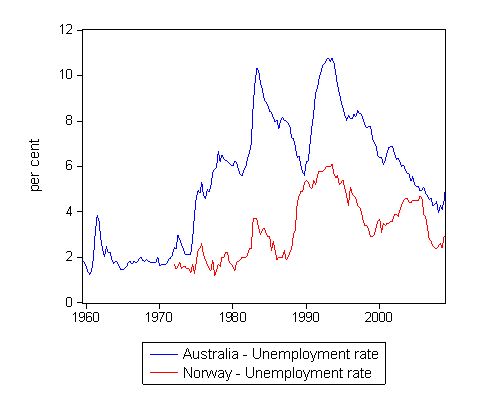
There has not been a single quarter where our unemployment rate has been lower than the rate in Norway. The next chart shows the difference between the Australian and the Norwegian unemployment rates in percentage points over the period from March 1972 to March 2009. You can see that the periods after each of the recessions, when employment growth had returned, that we failed badly to quickly bring our rates down again.
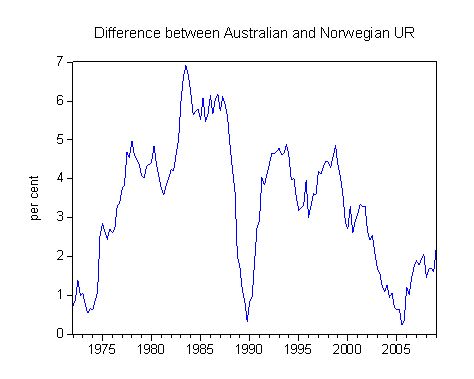
Second, a significant aspect of this failure has been the role of our public sector vis-a-vis that of Norway. Consider the following table which shows the percentage of public sector employment in total employment in each country. The data is hard to get but comes from OECD Historical Statistics (the 2005 proportions are guesses based on a chart rather than hard numbers for Norway).
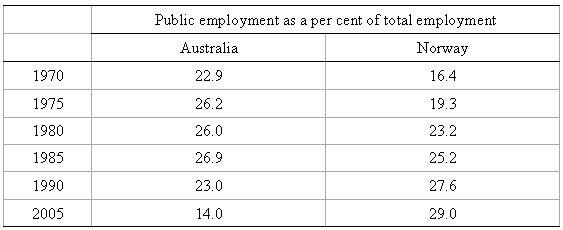
The public sector in Norway is a major contributor of employment in their economy. It has often been stated by neo-liberals that the reason our unemployment rate rose over the last three decades was because of the increased participation of women and the rise of the service sector. There were many spurious arguments used to justify these claims which I won’t rehearse here (I have written many words in academic papers about this in the past). But Norway had one of the highest rises in female participation rates since the mid-1970s and also faced the decline in manufacturing and related industries as their service sector grew.
The big difference is that while our service sector is expressed by the growth in “burger flipping” employment – casualised, low-skill, low-pay and going nowhere, in Norway, the public sector was a major source of service sector employment growth. These jobs were in personal care services, health, education and the like. Typically secure, well-paid skilled jobs that allowed that country to absorb these structural changes without the significant increases in unemployment or inequality that have marked Australia’s industrial shifts since the 1970s.
Further, by increasing the share of public employment in total employment, the Norwegian government has been able to use the public sector as a means to keep unemployment low and absorb the structural and cyclical shocks much better than us.
Third, in Norway long-term unemployment is defined as being unemployed for more than 26 weeks whereas in Australia we consider spells of unemployment greater than one year to represent long-term unemployment. This means that more intensive assistance is given to the LTU worker in Norway much sooner.
Fourth, Norway, like most Scandinavian countries considers its youth to be the future. In Australia, we allow our youth to wallow in high states of unemployment accompanied by no formal schooling/training requirements. In Norway, they targetted youth specifically with their Youth Guarantee which ensures that all youth between 20 and 24 years of age will be either employed; participating in formal education or receiving trade training.
Further, the Norwegian Government guarantees all youth below 20 years of age support for 3 years of upper secondary education. All those who leave upper secondary school and who are unemployed are immediately subsumed by the Youth Guarantee into a paid job (typically public sector) or a skills development program (which could be in the context of paid employment).
Fifth, unlike Australia which privatised the provision of labour market services and fragmented job matching, intensive assistance, training, welfare support etc, Norway retained these functions within the public sector. They do not seek to make profit or create an industry from the unemployment as has been the case in Australia.
Recent reforms in Norway established the Norwegian Labour and Welfare Administration (NAV) in 2006 by integrating the Public Employment Services, the National Insurance Services and the municipal social assistance services into one public body. It is a decentralised public sector organisation accessible to all Norwegians (by 2010 it will be available to all at their local level). The NAV is responsible for providing services to the unemployed; it runs labour market programmes (training etc); it conducts job placements and administers the unemployment benefits system.
It is truly a public sector “one stop shop” covering employment, welfare and skill development. The NAV also offers services to sick leave and disability recipients and other pensioners.
Compare this to what we currently have in Australia and the reforms currently being proposed by the Federal government and you just shake your head in disbelief.
I could also go into differences in their regional development and education policies and more but I think you get the message. Its cold over there in Norway but life is better for the fact that the Government actually acts to improve standards of living. A case can be made that in Australia successive federal governments since the mid-1970s have actually undermined broad standards of living by running budget surpluses and refusing to deal with the unemployment problem.
When asked by people how I judge public policy I say in terms of not how rich it makes the country overall but in how rich it makes the poor. Unemployment is one of the major causes of entrenched poverty and has insidious inter-generational effects such that the children of the unemployed inherit the disadvantage of their parents. In this respect, I consider public policy in Australia over the last thirty years or more has categorically failed us and we are now are verging on being a failed state.
We need a fundamental shift in policy in Australia and a renewed commitment by our public sector to create employment buffers to allow our economy to achieve the sort of outcomes that Norway provides to its residents.
Postscript on crime rates
Apropos of the comment made by Graham (see below), my initial inclination would have been just to say – well Norway has much lower crime rates than Australia but then my curiosity was pricked and so I decided to briefly do some research (which is what I do!). Computing crime rates is quite difficult not the least because of data limitations. But there is official data and here is what I quickly was able to assemble.
In 2007 (latest Norwegian data available from Statistics Norway shows that the crime rate per 1000 people was 85.1. For interest, I broke that down into the categories to come up with something that was comparable to the data available from the ABS. For Australia the latest data appears to be 2005. The population in Norway was 4,644,457 (2007) compared to the June 30, 2005 Australian population of 20,328,600.
The first table is for Australia using the ABS data while the second is for Norway. The net result for Norway excludes the (a) crimes which do not appear in the Australian statistics. While this analysis may be improved (it took a few minutes), the gap between Australia and Norway is likely to remain substantial. We seem to be much more violent towards each other than the Norwegians.
Second postscript on crime rates – Norway – April 13, 2009
Well despite the lower crime rates in Norway, it seems there is some interesting “criminal” behaviour. A report from Agence France-Presse today tells a story about a couple (a 28-year-old man driving with a 22-year-old woman passenger) who were caught having sex while doing 133km/h in a 100 zone near Oslo. The arresting cop said that the car was “veering from one side to the other because the woman was sitting on the man’s lap while he was driving and doing the act, shall we say.”
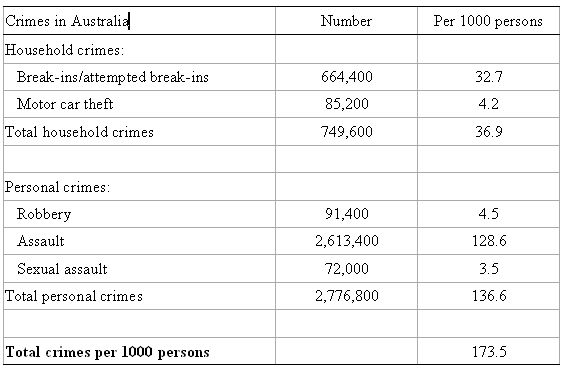
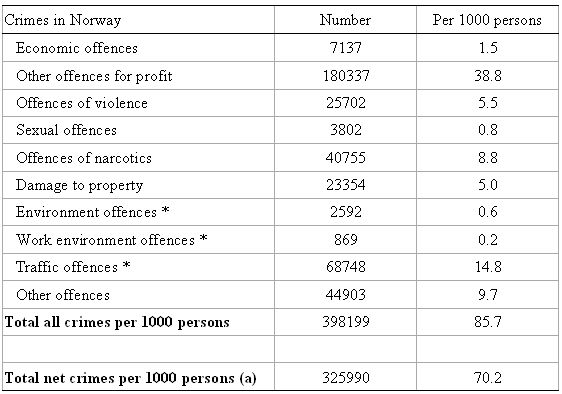
Dear Bill,
Though this story might be part of a blog on the social impacts of unemployment – crime, mental illness, etc. It would be nice to have details of Norway’s levels of crime, mental illness etc particularly amongst their disadvantaged – but maybe they don’t have any.
Cheers
Graham
http://www.smh.com.au/opinion/a-complex-link-between-recession-and-crime-20090412-a3yc.html?page=-1
Bill, am I able to access data on all the forementioned plus composition of the labour market, long term trends etc, through the CofFEE website? I have tried via the labour force section of the ABS website but apart from a few general tidbits such as the unemployment rate, I have not met with much success. Navigating the site is probably not helped by the fact that I have no formal IT training.
It is interesting to note that the long term public sector employment rate in Norway is a mirror-reverse of our own, starting from a low point near our current level and rising to nearly a third of the labour force.
While I believe that manufacturing no longer makes up any great portion of our labour force, those that remain seem to be dissapearing at a fast clip and I am wondering what sectors will absorb them once the downturn is over (assuming the govt fails to become a significant employer), for I do not believe that the industries will be returning to our shores. The service sector itself seems to be offshoring, and why wouldn’t it? It must surely be cheaper to do many things from say, Mumbai, and “export” them to Australia at the push of a button. I remember being told many years ago not to worry about all the skilled blue-collar jobs that were vanishing from this country because newly-rising service industries would soak up all the unemployment. But not only has the unemployment rate rarely been relatively low, except perhaps at the top of the boom just busted, massive expansion and and advances in the world wide web appears to me to be increasingly rendering local service sector jobs redundant.
Dear Graham
I have done some analysis as a postscript to the main post above. The two tables above tell all.
Best wishes
bill
Dear Lefty
What data do you want? In general, we do not provide data from CofFEE unless it is our own creations – like our labour market indicators (CLMI) or, more recently the EVI. But I can easily assemble data if you are curious from the various sources available.
The pattern you note with respect to public employment in the two countries is pretty emphatic. As I indicated in the blog, the Norwegian government has ensured via its own direct employment capacity that the types of structural changes that all our economies have undergone over the last several decades have not meant that unemployment (or underemployment) rates have risen.
With respect to manufacturing, I agree that there is trend decline in that sector in Australia (and Norway by the way). But it is still quite an important sector (see the following table). I assembled ABS Labour Force data by industry and computed total employment (in 000s) and percentage of total employment (%) for the 17 one-digit industries under ANZSIC. I did this for 1985, 1997 and 2008 to give you an idea of the shifts. You can see that manufacturing is still 10.2 per cent of total employment.
But just because jobs shift across national borders as capitalists seek better profits does not mean we need to have high unemployment. There are many activities that cannot shift and new activities that can be spawned. But we will never do this unless the Australian government starts to act more like Norway’s government. That was the point of the blog. There are hundreds of thousands of jobs in personal care services, environmental care services, in renewable energy manufacturing, in education, in cultural and recreational services that are waiting for the government to fund.
Hi guys,
Yes, well I understand. We are having the same problems as other countrys at the moment. I heard our economy will not grow
this year. I think also alot of people have lost their jobs in the government sector. The Prime Minister is thinking about more
spending as well just like other countries. I have just finsihed a Maths degree and don’t know what my job prospects are?
Thanks for providing those numbers Bill, and for the offer to assemble data. I am simply curious about these sorts of things as I have a strong innate urge to know what “makes things tick”.
I certainly agree that our government could take some cues from Norway.
Well here you go Bill – the fed is committed to returning the budget to surplus as soon as possible.
“The government reaffirms it committment to achieve budget surpluses, on average, over the economic cycle.
As the economy recovers, and grows above trend, the government will take action to return the budget to surplus by:
. allowing the level of tax reciepts to recover naturally as the economy improves, while maintaining the governements committment to keep taxation as a share of GDP below the 2007-2008 level on average; and
.holding real growth in spending to 2% a year until the budget returns to surplus”
budget 2008-2009, part 4; fiscal strategy and outlook.
Hmm – how does the budget return to surplus if taxation does not rise above the 2007-2008 level but real spending growth continues to increase at 2% a year? Doesn’t that imply a deficit, even if only a small one?
Dear Lefty
The statement does not say taxation will not rise. It says the share of taxation in GDP will not rise. So as GDP grows again, the total tax take can easily rise and exceed the nominal outlays equivalent to a real growth of 2 per cent. At higher GDP growth rates, the budget would be back in surplus soon enough. So it is not so much a matter of the accounting that is baffling it is why they would want to commit to this which would imply they want to get the private sector back into dissaving and/or allow the economy to wallow in high rates of labour underutilisation weighed down by the fiscal drag (the surpluses). Totally miscontrued representative of what their responsibilities are as a national government and what their opportunities are to use those responsibilities to make all of us prosper.
best wishes
bill
Its also interesting to note that last year Andrew Leigh found that Norway has a lower intergenerational earnings elasticity of income then Australia, and thus a higher level of social mobility. Another symptom of the same problem?
Dear Stuart
Definitely. When you have high levels of employment and well-paid jobs in general you will achieve better equity. We let the private market develop the service sector – with low paid, casualised jobs in food etc (probably contributing to the obesity epidemic in this country), whereas the Norwegian public sector saw the decline of manufacturing etc as an opportunity to develop their service sector – with high paid jobs in human services. A world of a difference in approach and outcome.
best wishes
bill